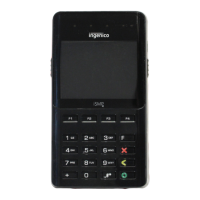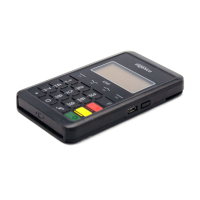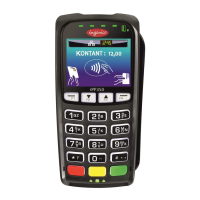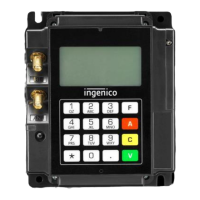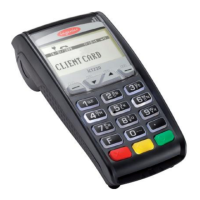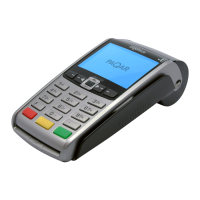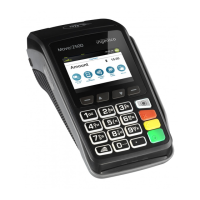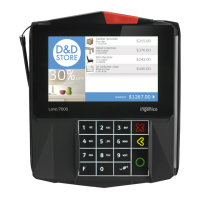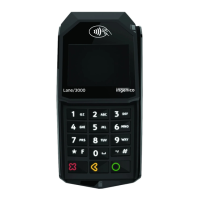Do you have a question about the Ingenico IWL 250 and is the answer not in the manual?
Details the terminal base, its function, and connection requirements.
Instructions on how to turn the terminal on and off.
Identifies and explains the purpose of each function key on the terminal.
Guidelines for determining the quantity of terminals and bases needed for installation.
Advice on selecting optimal locations for communication and charging bases.
Lists common items that can interfere with wireless communication signals.
Procedures for testing and ensuring adequate wireless signal strength for terminal operation.
Method for evaluating wireless coverage before equipment installation.
Steps to confirm wireless coverage after the terminal is installed on site.
Steps to test the wireless connection quality between terminal and base.
Process for linking a terminal to its designated communication base.
Steps to take when experiencing problems with terminal communication.
Details on configuring the IP address for the communication base.
Procedure for replacing or exchanging communication bases.
Information on locating the MAC address of the terminal base for network registration.
Guidance on charging the terminal battery and maintaining its lifespan.
Explains the meaning of different battery level indicators displayed on the terminal screen.
Recommendations for initial and ongoing battery charging practices to extend life.
Step-by-step instructions for replacing the terminal's removable battery.
How to replace the paper roll in the terminal's built-in printer.
Details on approved paper types and proper storage conditions for thermal paper.
Guidelines for cleaning the terminal's plastic parts and reader heads.
Accessing additional options within the Stand-Alone Setup Menu for configuration.
Configuring system-wide settings for the terminal, including date and time.
Procedure for setting the correct date and time on the terminal.
Configuring various operational options and preferences for the terminal.
Customizing receipt printing settings, such as pauses, copies, and footer messages.
Generating and viewing various reports from the terminal, like batch details.
Performing essential maintenance tasks on the terminal, such as association checks.
Information on contacting support for assistance with terminal issues.
Enabling a mode for staff training without transmitting live transactions.
Setting and managing merchant and administrator passwords for terminal access.
Displaying terminal information such as the Terminal ID and network status.
Accessing additional transaction options from the main transaction menu.
Processing a payment transaction for a sale of goods or services.
Option to add a tip to a transaction, either by percentage or a fixed amount.
How to add a tip based on a pre-set or custom percentage of the sale.
How to add a tip by specifying a fixed monetary amount for the transaction.
Procedure for processing a refund for a previous sale transaction.
Cancelling a transaction before it is settled in the current batch.
Re-printing a previous transaction receipt from the terminal.
Manually posting a sale that was authorized via telephone communication.
Steps for installing the Terminal Gateway Interface (TGI) client on the POS computer.
How to find the IP address of the POS (RMS) computer for terminal configuration.
Setting up the terminal to communicate with the POS system and defining network parameters.
Checking the current status and connectivity of the terminal on the network.
Overview of how to operate the terminal for various payment and transaction functions.
Processing a complete payment for a bill in a single transaction.
Procedures for adding a tip to a transaction, covering both percentage and amount.
Performing payments using contactless methods (TAP) or PIN entry.
How to process payments made by cash when the option is enabled.
Dividing a total bill into multiple separate payment transactions by different methods.
Details the terminal base, its function, and connection requirements.
Instructions on how to turn the terminal on and off.
Identifies and explains the purpose of each function key on the terminal.
Guidelines for determining the quantity of terminals and bases needed for installation.
Advice on selecting optimal locations for communication and charging bases.
Lists common items that can interfere with wireless communication signals.
Procedures for testing and ensuring adequate wireless signal strength for terminal operation.
Method for evaluating wireless coverage before equipment installation.
Steps to confirm wireless coverage after the terminal is installed on site.
Steps to test the wireless connection quality between terminal and base.
Process for linking a terminal to its designated communication base.
Steps to take when experiencing problems with terminal communication.
Details on configuring the IP address for the communication base.
Procedure for replacing or exchanging communication bases.
Information on locating the MAC address of the terminal base for network registration.
Guidance on charging the terminal battery and maintaining its lifespan.
Explains the meaning of different battery level indicators displayed on the terminal screen.
Recommendations for initial and ongoing battery charging practices to extend life.
Step-by-step instructions for replacing the terminal's removable battery.
How to replace the paper roll in the terminal's built-in printer.
Details on approved paper types and proper storage conditions for thermal paper.
Guidelines for cleaning the terminal's plastic parts and reader heads.
Accessing additional options within the Stand-Alone Setup Menu for configuration.
Configuring system-wide settings for the terminal, including date and time.
Procedure for setting the correct date and time on the terminal.
Configuring various operational options and preferences for the terminal.
Customizing receipt printing settings, such as pauses, copies, and footer messages.
Generating and viewing various reports from the terminal, like batch details.
Performing essential maintenance tasks on the terminal, such as association checks.
Information on contacting support for assistance with terminal issues.
Enabling a mode for staff training without transmitting live transactions.
Setting and managing merchant and administrator passwords for terminal access.
Displaying terminal information such as the Terminal ID and network status.
Accessing additional transaction options from the main transaction menu.
Processing a payment transaction for a sale of goods or services.
Option to add a tip to a transaction, either by percentage or a fixed amount.
How to add a tip based on a pre-set or custom percentage of the sale.
How to add a tip by specifying a fixed monetary amount for the transaction.
Procedure for processing a refund for a previous sale transaction.
Cancelling a transaction before it is settled in the current batch.
Re-printing a previous transaction receipt from the terminal.
Manually posting a sale that was authorized via telephone communication.
Steps for installing the Terminal Gateway Interface (TGI) client on the POS computer.
How to find the IP address of the POS (RMS) computer for terminal configuration.
Setting up the terminal to communicate with the POS system and defining network parameters.
Checking the current status and connectivity of the terminal on the network.
Overview of how to operate the terminal for various payment and transaction functions.
Processing a complete payment for a bill in a single transaction.
Procedures for adding a tip to a transaction, covering both percentage and amount.
Performing payments using contactless methods (TAP) or PIN entry.
How to process payments made by cash when the option is enabled.
Dividing a total bill into multiple separate payment transactions by different methods.
| Battery | Rechargeable lithium-ion battery |
|---|---|
| Weight | 300 g |
| Printer | Integrated thermal printer |
| Display | Color display |
| Connectivity | GPRS, Wi-Fi, Bluetooth |
| Card Reader | Magstripe, EMV chip, NFC |
| Security | PCI PTS compliant |
| Payment Methods | Credit/Debit cards, Contactless payments |

